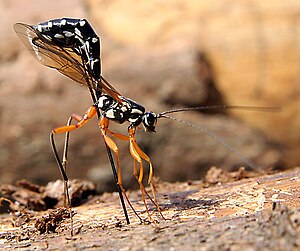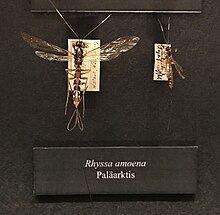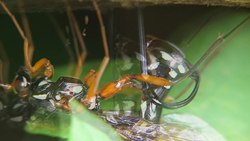Wood wasp parasitic wasp
| Wood wasp parasitic wasp | ||||||||||||
|---|---|---|---|---|---|---|---|---|---|---|---|---|

Female of the parasitic wasp laying eggs |
||||||||||||
| Systematics | ||||||||||||
|
||||||||||||
| Scientific name | ||||||||||||
| Rhyssa persuasoria | ||||||||||||
| ( Linnaeus , 1758) |
The parasitic wasp ( Rhyssa persuasoria ), also known as the giant parasitic wasp , is a common parasitic wasp species in the northern hemisphere . Their larvae are parasitoids of wood wasp larvae, such as the giant wood wasp . The species was introduced to South America, New Zealand and Australia to control the introduced blue spruce wasp.
features
The parasitic wasp parasitic wasp is a very large, gracefully built parasitic wasp with a body length between 18 and 35 millimeters, with long, thread-like antennae and an elongated, cylindrical abdomen. In the female, there is also a slender ovipositor of almost the same length, which protrudes long behind the abdomen in the resting position. The basic color of the body of the female is black, with white (to yellowish-white) markings. Two bands in front of the head, on the inside of the complex eyes , a spot on the forehead (frons) and on the temples are white . On the middle section (mesosoma) there are white parts of the pronotum, the wing scales (tegulae) and a band below it, parts of the mesopleurs, scutellum and postscutellum and spots on the propodeum . The tergites have rows of white spots on the free abdomen (metasoma) . The antennae are colored reddish-brown, always without a central white band, and the clypeus can also be brown-red. The legs are colored red, mostly with brownish darkened thighs (femora), only on the hind legs also rails (tibiae) and feet (tarsi). Occasionally the legs are spotted a little yellow. The male is colored like the female, only the face, front and middle hips and the two sections of the trochanter , which is divided into two parts (trochanter and trochantellus) on these legs , as is typical for all parasitic wasps, are spotted yellow, often black.
The species can be distinguished from the members of the similar, also similarly large genera Rhyssella and Megarhyssa by a tooth-like protrusion (tubercle) in the front of the clypeus, while lateral tubercles do not occur. In addition, the first tergite of the free abdomen has a deep dimple on each side, the ovipositor of the female is also shorter in relation to the body length than that of Megarhyssa and the free abdomen bears a tubercle on each side on sternites 2 to 4, which serves as a guide for the ovipositor . Features common to all members of the Rhyssinae, which enable the differentiation from other subfamilies of the parasitic wasps, are for example: cross vein 2m-cu in the middle of the wing, mesoscutum (back plate) strikingly coarse and irregularly striated across the entire surface, propodeum without longitudinal keels. They differ from the genus Pseudorhyssa (subfamily Poemeniinae). a. due to the missing quills.
From the two other species of the genus that live in Central Europe, the species can be reliably distinguished on the basis of color characteristics. Females of Rhyssa kriechbaumeri have a black face (without white stripes, sometimes with two small white spots) and a pure black propodeum, in Rhyssa amoena the middle antenna links are colored white, so that the antenna has a central white band, and the clypeus is yellow . Rhyssa persuasoria is thus one of the few parasitic wasps that can be determined relatively reliably down to the species even by non-specialists.
Way of life
The larvae of the species are idiobionte ectoparasitoids of wood wasp larvae. This means: the ichneumon wasp paralyzes the wood wasp larva when laying its eggs with a poison sting, so that it continues to live, but is no longer active and no longer grows; In addition, the parasite larva lives on the outside of the host larva, in which it is anchored only through the mouthparts. The sawfly parasitic wasp goes through four larval stages.
Larvae
The wood wasp larva eats in a passage hidden deep in the wood, its presence is not easily recognizable from the outside. The female parasitic wasp recognizes trees infested by wood wasps by their smell; in fact, it does not smell the wasp larva itself, but the wood-degrading fungus (of the genus Amylostereum ) that it has brought with it, with the help of which the wood wasp larva can digest the wood. Once suitable wood has been found, the parasitic wasp runs around on it, intensively scanning the surface with the antennae and scanning cavities (possible feeding tunnels of the wood wasp larvae) with the ovipositor. Noises or vibrations caused by the feeding activity of the host larva do not seem to play an essential role in the search, because they also attack the immobile pupa stage. For the drilling, the female stretches the elongated abdomen upwards and brings the ovipositor into a vertical or almost vertical position. The thin ovary is supported and guided at the point of attachment by the ovary sheath, which slides away to the sides as the drilling progresses (it is provided with a transverse groove for this purpose), and the tubercles of the abdomen also serve as a support device. Drilling through the hard wood takes a long time (5 to 33 minutes), but test drillings of a few minutes are common. The hole does not have to be straight, the wasp is able to fine-tune the flexible drill in a curve in the wood. The egg is unusually elongated for passage through the thin ovipositor. The first three larval stages anchor themselves in the host with their long, sickle-shaped mandibles and feed on escaping body fluid ( hemolymph ). The fourth larval stage then eats the host larva almost completely. The larva takes about five weeks to grow. The adult larva then spins a thin cocoon in the feeding tunnel of the wood wasp larva and hibernates in it (as an old larva that is ready to pupate or "prepupa"). Pupation takes place in the following spring. Few individuals, however, go through an abbreviated development and hatch in the same summer; this leads to a partial second generation. The parasitization occurs mainly in spring.
Adults
Although adult wasps are able to parasitize new hosts without ingesting food, the life expectancy increases four to five times with significantly increased activity when the wasps eat them. Food in the imaginal stage is carbohydrates such as sugar and starch, which are obtained, for example, by eating honeydew or on pine needles. Flowers are not visited. The adults' flight time ranges from late spring (April) to mid-summer (August). Adults mainly fly in forests.
Hosts
The wood wasp parasitic wasp specializes in wood wasp larvae of the Siricidae family , for example of the genera Sirex , Urocerus and Xeris . She prefers conifers. Although there is also numerous information about wood-dwelling beetle larvae as hosts, it is considered uncertain that these are regularly used as hosts. Most of the information may be due to mix-ups (common occurrence with wood wasp larvae in the same wood) or rare false hosts.
Relationships with other parasitic wasps
The species Pseudorhyssa maculicornis is a kleptoparasite of the parasitic wasp: With its much weaker ovipositor it only lays an egg on the wood wasp larva when it has already been parasitized by Rhyssa persuasoria (and thus a hole has been pre-drilled). The Pseudorhyssa larva then displaces the Rhyssa larva . Rhyssa persuasoria itself can develop as a hyperparasitoid , on larvae of other parasitoid hymenoptera on the wood wasp larvae.
distribution
The species is distributed holarctic . The huge area includes Eurasia east to Japan and North America. In Europe it occurs as far as the Mediterranean region (evidence from Spain, Italy, Greece), but is absent in tropical Africa.
Biological pest control
To combat the blue spruce wood wasp ( Sirex noctilio ), the species was imported as a biological antagonist, released and settled in various countries where it was not previously native. The wood wasp had also been introduced there and had developed into a serious economic pest on planted pine crops, the economic importance of which is far greater than in its original home. Rhyssa persuasoria was not alone in this, but together with other imported parasitoids such as Megarhyssa nortoni and Ibalia leucospoides (family Ibaliidae ) locally quite successful, even if the parasitic nematode Beddingia siricidicola ultimately proved to be more successful. Further settlements for the same purpose took place in New Zealand and Brazil.
Taxonomy and systematics
The species was first described by Carl von Linné as Ichneumon persuasorius . In addition to the nominate form , three subspecies are recognized, which essentially only differ in terms of their coloration:
- Ryssa persuasoria himalayensis Wilkinson , 1927
- Rhyssa persuasoria neoalensis Kamath & Gupta , 1972
- Rhyssa persuasoria nigrofacialis Meyer , 1922
The species belongs to the relatively small subfamily Rhyssinae with 8 genera and almost 250 species worldwide, of which only 3 genera with 11 species occur in the western Palearctic . With older authors they were still included as a tribe Rhyssini in the subfamily Pimplinae. The Rhyssinae as well as the genus Rhyssa can form a monophyletic group according to current knowledge.
Individual evidence
- ↑ cf. Fig.3 ( Memento of the original from April 12, 2013 in the Internet Archive ) Info: The archive link was automatically inserted and not yet checked. Please check the original and archive link according to the instructions and then remove this notice.
- ^ A. Varga: A review of the subfamily Rhyssinae (Hymenopters, Ichneumonidae) from the Ukrainian Carpathians. Vestnik zoologii 48, 1, pp. 27–34, 2014 doi: 10.2478 / vzoo-2014-0003
- ↑ Wang Xiaoyi & Yang Zhongqi (2008): Behavioral mechanisms of parasitic wasps for searching concealed insect hosts. Acta Ecologica Sinica 28 (3): 1257-1269.
- ^ Helen Hocking, Studies on the biology of Rhyssa persuasoria (L.) (Hymenoptera, Ichneumonidae) incorporating an x-ray technique. Journal of the Australian Entomological Society, 7, pp. 1-5, 1968
- ↑ JD Spradberry: Host finding by Rhyssa persuasoria (L.) an ichneumonid parasite of Siricid woodwasps. Animal Behavior, 18, pp. 103-114, 1970
- ↑ Helen Hocking (1967): The influence of food on longevity and oviposition in Rhyssa persuasoria (L.) (Hymenoptera, Ichneumonidae). Journal of the Australian Entomological Society 6: 83-88.
- ↑ Mike G. Fitton, MR Shaw, ID Gauld: Pimpline Ichneumon-flies (Hymenoptera, Ichneumonidae, Pimplinae). Handbooks for the Identification of British Insects Vol. 7, Part 1, published by the Royal Entomological Society of London, 1988 ISBN 0-901546-72-0
- ↑ Rhyssa ( Memento of the original from April 20, 2014 in the Internet Archive ) Info: The archive link was inserted automatically and has not yet been checked. Please check the original and archive link according to the instructions and then remove this notice.
- ^ SA Rohwer: The north-American Ichneumon flies of the tribes Labenini, Rhyssini, Xoridini, Odontomerini and Phytodietini. Proceedings of the US National Museum Vol 57 no. 2317, pp. 405-474.
- ↑ American Entomological Institute website ( Memento of the original from April 12, 2013 in the Internet Archive ) Info: The archive link was inserted automatically and has not yet been checked. Please check the original and archive link according to the instructions and then remove this notice.
- ↑ Waspweb: Rhyssinae of the African Tropical Region
- ^ KL Taylor: Studies with Sirex noctilio (Hymenoptera, Siricidae) and its parasites that illustrate the importance of evaluation biological control events . Acta Öcologica Vol.1, no.2, pp. 181-187, 1980
- ^ Rhyssa fact sheet: Landcare Research
- ↑ ET Every SRC Penteado, WR Filho, EC Schaitza: Updated situation of Sirex Noctilio integrated management program in Brazil. Tecnica series IPEF 13, pp. 11-20, 2000
- ↑ Donald LJ Quicke, Nina M. Laurenne, Mike G. Fitton, Gavin R. Broad: A thousand and one wasps: a 28S rDNA and morphological phylogeny of the Ichneumonidae (Insecta: Hymenoptera) with an investigation into alignment parameter space and elision. Journal of Natural History, 43, 23, pp. 1305-1421, 2009 doi: 10.1080 / 00222930902807783

